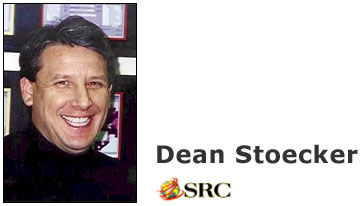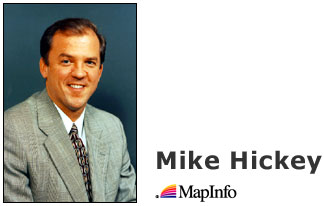Dean Stoecker: Regardless of how hard the RDBMS [relational database management systems] and GIS vendors have pushed, spatial technology is nowhere close to being mainstream function within IT organizations of large companies.Yes, there are the clusters of companies that view their total business from a geographic perspective, but we have not seen the wholesale buy-in to spatial as either a technology or a business strategy.The spatial vendors focusing on the front and back office have been trying to "will" this to happen but in essence, it is difficult to take a horizontal capability as spatial is and mainstream it when applications are often vertically/functionally driven.Moreover, ROI (return on investment) can be difficult to estimate and measure in some of the less pure spatial applications, unlike logistics, asset management and insurance underwriting.More and more, without a good ROI story, corporate buy-in at any level is tougher. Vendors, particularly on the database side, have done a great job at enlightening IT professionals about the benefits of spatial and justifying quite clearly the benefits of maintaining spatial data in the same environments as other corporate data, in the RDBMS.On the other hand, the GIS/visualization vendors have tried to push spatial largely with the focus on the map, which tends to change the emphasis from how spatial gets used as opposed to how it gets managed.Spatial is a capability looking for a business problem and most of the business problems are identified and solved in functional areas like sales, marketing, planning, logistics.So, I suspect we will not be seeing the CGO (Chief Geography Officer) title anytime soon in corporate America.On a positive note, when companies like Microsoft, Oracle, and IBM push spatial capabilities as they do, things are bound to change with more time.Even with the giants pushing this, it will be a long time before spatial is viewed in a ubiquitous way.
Mike Hickey: Although many Fortune 1000 companies are beginning to see the benefits of incorporating GIS and spatial technology into their business processes, it has not yet become a mainstream IT function.However, we think this will change over the next five years as companies begin to upgrade their customer relationship management (CRM) applications in order to best find, serve, and grow their customer base.A critical component that is now being added to CRM systems is location-specific technology.Location-specific information enhances CRM processes so that companies are better able to satisfy customer needs.IDC expects that the CRM analytic applications sector will be a strong market for location-specific CRM technology and the market will increase 53% to $2.38 billion in 2004.As location-enabled technology becomes more pervasive with the availability of spatial technology within databases, analytic and CRM applications, companies will increasingly use location as a significant element in their information systems. MapInfo is driving the trend of adding location-specific information to CRM applications.MapInfo's products and services enable businesses to gather information from various touch points, such as call centers, operational databases, Web servers and e-commerce transactional databases, to gain a single, comprehensive view of their customers.With this information an organization is able to create localized and personalized campaigns, services and products for customers, as well as determine customer potential and identify where to target for future growth.
Dean Stoecker: Nothing sells better than a solid ROI.Unfortunately, having spatial application requirements does not automatically assume an ROI is easy to calculate.Clearly the most powerful applications are those with easy to obtain financial returns.A trucking company who can save $12 million a year in fuel with optimized routing applications or insurance companies who can reduce risk exposure by $100 million a year with spatial analysis of policy holders makes the internal selling job easier.Not all GIS applications are quite so easy to quantify the returns on because spatial analysis is just part of the mix.For example, a retailer who uses some spatial analysis in a direct mail campaign as part of a CRM initiative will have the challenge of determining the role spatial plays in the overall analysis versus the response models used to select the lists.But it is also safe to say that using the web as the delivery medium for deep and wide deployment of a broad based business application results in a large collective ROI, even if the spatial application has marginal return for a single use or user.A company using spatial applications in support of site location analysis in a desktop environment might see slight absolute dollar returns on a particular project, but when replicated to hundreds, or thousands of users over the web, the absolute returns can be enormous.For wireless, clearly there are some early winners for spatial applications like E-911, but overall I think the vendor community will spend billions of dollars over the next few years "duking" it out only to find that the 'killer' apps are few and far between, and the ROI for wireless apps is more elusive still. Mike Hickey: Applications that address an organization's desire for improved operational efficiencies and increased productivity and support large field forces have much to gain from location-enhanced applications.For business travelers, applications that enable, remote access to directions and maps as well as customer locations via a mobile device can be a vital value-add service.In addition, sales organizations, field technicians, and delivery staff benefit from unified access to enterprise databases remotely and this is a clear productivity enhancement.Location plays an instrumental role in determining the context for unified information retrieval for these groups. For example, British Telecommunications is using MapInfo technology that allows its 17,000 field service engineers to respond and rectify network problems faster and more effectively, culminating in an expected $33 million in savings over the next five years.In this example, BT is relying on spatial information to help its engineers deliver superior customer service with faster access to information in the field. Gearworks is another company offering the transportation industry ROI benefits through the use of spatial information.Gearworks developed its etrace™ solution using a suite of MapInfo's location-based technology.With etrace, businesses using commercial fleets, such as trucking, field service and delivery companies, benefit from improved communications between dispatchers, mobile workers and customers, resulting in reduced operating costs, enhanced customer service and increased revenue opportunities. |

